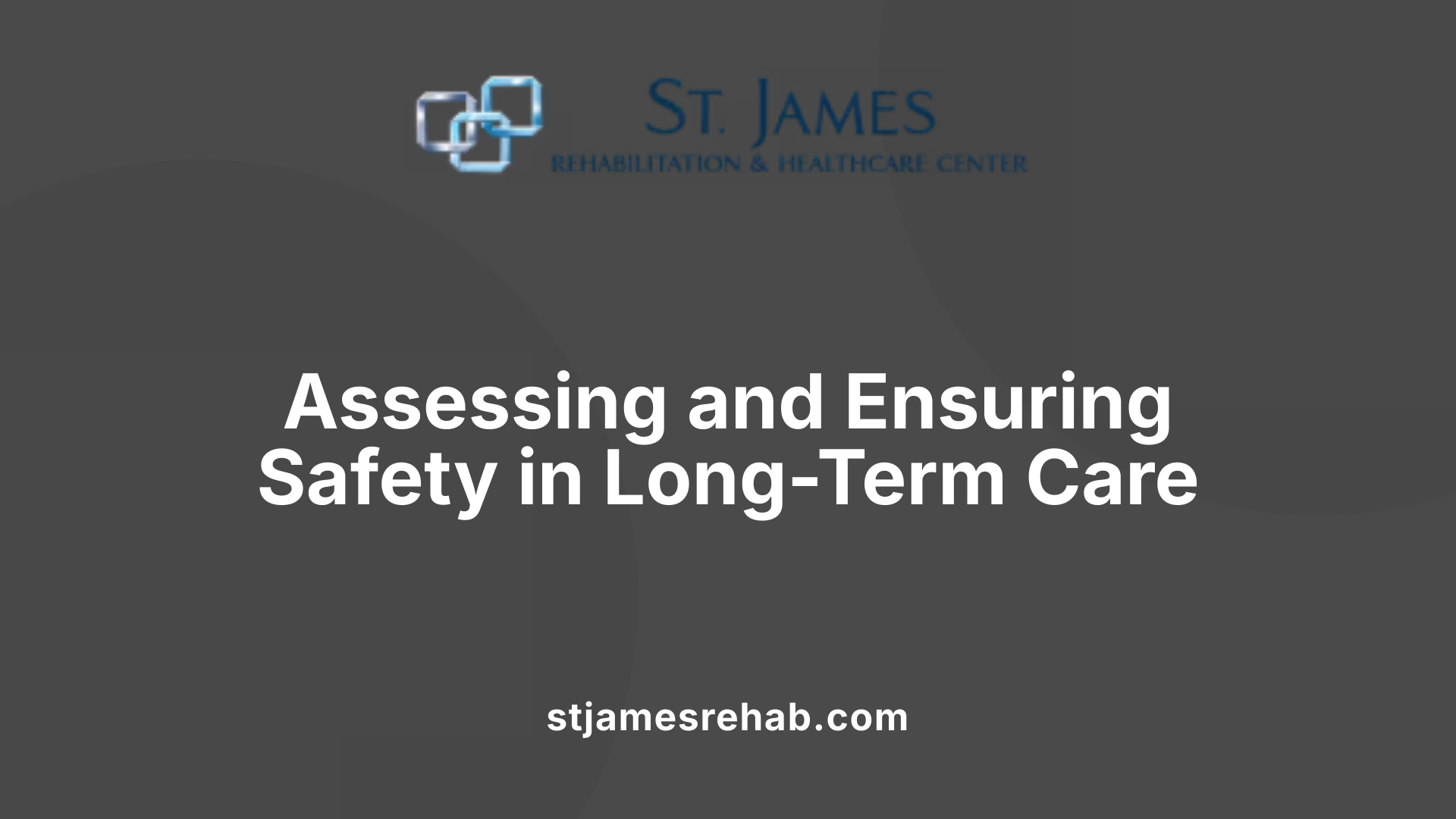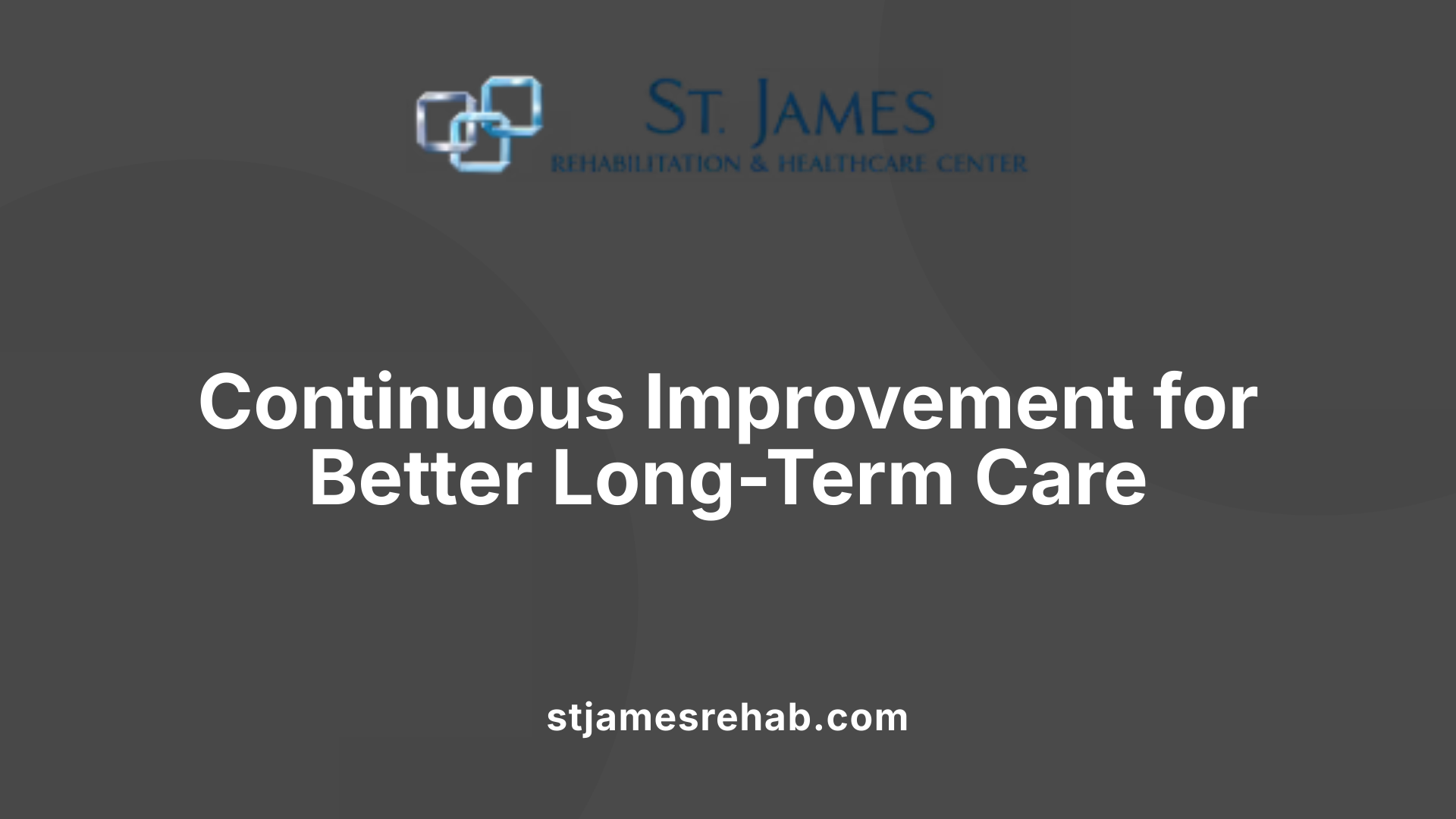The Role of Long-Term Care in Enhancing Quality of Life
Transforming Senior Living Environments for Better Well-being

Understanding Long-Term Care and Its Critical Role
Long-term care (LTC) plays a vital role in supporting individuals with chronic illnesses, disabilities, or age-related conditions. It encompasses a range of services designed to enable independence, promote dignity, and improve overall quality of life across various settings, including homes, assisted living facilities, and nursing homes. This comprehensive overview details the nature of LTC, its various forms, and its significance in fostering well-being among older adults.
Defining Long-Term Care and Its Core Objectives

What is long-term care?
Long-term care (LTC) encompasses a broad spectrum of services aimed at helping individuals who cannot independently manage daily activities due to aging, illness, or disability. These services are essential for maintaining their health, safety, and dignity.
LTC can be delivered in multiple settings, including a person's home, community-based programs, assisted living centers, or nursing homes. The services provided vary widely and include medical treatment, personal assistance with daily tasks, and social support to foster engagement and mental well-being.
One of the primary goals of LTC is to promote independence as much as possible. It helps individuals retain autonomy and improve their quality of life through tailored support that respects their human rights and dignity.
Effective long-term care relies heavily on coordination between formal caregivers, such as healthcare professionals, and informal caregivers, often family members or friends. This collaboration ensures comprehensive and continuous support.
The need for LTC can develop gradually with aging or unexpectedly after health-related incidents, making future planning crucial. Funding for LTC varies, coming from personal savings, government programs like Medicaid and Medicare, or private insurance, depending on the individual’s circumstances.
What are the primary goals of LTC?
The main objectives of long-term care include preventing or reducing functional decline, rehabilitating individuals to regain lost abilities, and providing supportive environments that promote well-being.
Beyond health restoration, LTC emphasizes enhancing quality of life by addressing emotional, social, and psychological needs. It aims to foster social connections, promote mental health, and ensure safety.
A significant focus is also placed on maintaining human dignity and respecting individuals’ preferences, choices, and cultural backgrounds. Innovative models like resident-centered care and environmental redesign are being explored to further improve satisfaction and overall well-being.
The overarching aim of LTC is not only to meet basic health needs but also to support a holistic approach that enables individuals to live meaningful, engaged lives despite their health challenges.
| Aspect | Description | Importance |
|---|---|---|
| Settings | Home, community-based, assisted living, nursing homes | Flexibility and accessibility for different needs |
| Services | Medical care, personal assistance, social support | Addresses diverse needs beyond health |
| Goals | Independence, dignity, quality of life, safety | Core to person-centered care |
| Challenges | Staffing shortages, funding, quality measurement | Areas for ongoing improvement |
| Innovations | Resident-centered care, environmental redesign | Enhancing quality and satisfaction |
Understanding the multifaceted nature of long-term care helps stakeholders develop better policies, improve service quality, and ultimately support individuals in maintaining their independence, dignity, and well-being.
Various Settings of Long-Term Care and Their Functions

What are examples of long-term care?
Long-term care encompasses a range of services designed to support individuals with ongoing health, personal, and social needs. These services are provided over extended periods, often due to chronic illness, disability, or age-related decline.
Examples of long-term care settings include:
- Nursing Homes or Skilled Nursing Facilities: Provide around-the-clock medical and personal care for individuals with significant health needs.
- Assisted Living Facilities: Offer housing, meals, medication management, and support with daily activities, while promoting independence.
- Home and Community-Based Services (HCBS): Delivered in individuals’ homes or community settings, such as personal assistance, transportation, and health monitoring by informal (family, friends) or formal (care professionals) caregivers.
- Continuing Care Retirement Communities (CCRCs): Integrate multiple levels of care, enabling residents to transition smoothly as their needs change within the same community.
- Adult Day Care Centers: Provide social engagement, supervised activities, and health support during daytime hours.
- Community-Based Programs: Includes support groups, social clubs, and assistance programs aimed at maintaining social connections and independence.
These diverse settings highlight the flexibility and broad scope of long-term care services tailored to individual needs.
Who needs long-term care?
A significant portion of the population will require long-term care at some stage of their lives. This need is especially prevalent among older adults and those with chronic conditions or disabilities.
Generally, the likelihood of requiring long-term care increases with age. For example, a large percentage of those over 90 experience disabilities that mean they cannot perform daily activities without assistance.
Long-term care can be provided informally, usually by family members or friends, or formally, through trained care professionals. Formal care settings include home health services, assisted living facilities, and nursing homes.
Planning for long-term care is essential because these services are often not fully covered by Medicare or other health insurance, and costs can quickly add up. Early awareness of who might need support and when to seek appropriate services can help ensure that individuals receive suitable, timely assistance.
Understanding the diverse environments and the needs they serve allows families and policymakers to make informed decisions, coordinate care effectively, and promote quality of life for those at risk of or experiencing long-term health challenges.
Population Demographics and Long-Term Care Needs

Statistics on aging populations
Globally, the demographic landscape is transforming, with a significant increase in the number of older adults. It is estimated that approximately 142 million older individuals are unable to meet their basic needs independently. This aging trend is particularly pronounced in Europe and North America, where the proportion of the population aged 60 and above continues to grow rapidly.
In Europe, up to 80% of people over 65 rely on some form of long-term care, often provided informally by family members or community caregivers. Similarly, in the United States, about 70% of adults aged 65 and over will require long-term care at some point during their lives. These figures highlight the increasing dependence on long-term care services as populations age.
The aging phenomenon has profound implications for healthcare and social support systems. As the number of seniors increases, so does the demand for diverse care settings, including nursing homes, assisted living facilities, community-based services, and in-home care. This surge emphasizes the need for sustainable, accessible, and high-quality LTC systems worldwide.
Risks for needing LTC among different socio-economic groups
The necessity for long-term care is unevenly distributed across different socio-economic groups. Individuals with lower income levels, poorer health status, and limited access to healthcare are at higher risk of requiring long-term assistance. Women, in particular, constitute nearly two-thirds of informal caregivers and are more likely to need long-term care themselves due to longer life expectancy and higher prevalence of chronic conditions.
People living alone also face increased risks of health decline and dependence, making informal and formal LTC services vital. Additionally, those with lower socioeconomic status often face barriers such as affordability issues, reduced access to quality care, and inadequate support networks.
Data suggests that disparities in LTC access and quality correlate with socioeconomic factors, with underserved populations more likely to experience deficiencies in care quality and safety. These disparities can exacerbate health inequalities, emphasizing the importance of equitable LTC policies and interventions.
The interplay of age, gender, socio-economic status, and living arrangements shapes the landscape of LTC needs, underscoring the importance of tailored approaches that address these diverse factors.
| Population Segment | LTC Needs and Challenges | Supporting Factors | Impact on Care Systems |
|---|---|---|---|
| Older Adults (60+) | Increased dependence on formal and informal LTC | Age-related health decline, chronic conditions | Rising demand for care facilities, services |
| Women | Higher likelihood of caregiving and needing care | Longer life expectancy, higher prevalence of disability | Increased caregiver burden, gender disparities |
| People Living Alone | Greater risk of social isolation and health deterioration | Limited household support | Need for community-based and in-home services |
| Low Socioeconomic Groups | Barriers to access, poorer health outcomes | Economic constraints, limited healthcare access | Disparities in care quality, outcomes |
Through understanding these demographic trends and socio-economic disparities, stakeholders can better plan, resource, and implement LTC systems that are inclusive, effective, and sustainable across different populations.
The Impact of Aging on Long-Term Care Demand

How aging increases LTC needs
As populations worldwide grow older, the demand for long-term care (LTC) significantly rises. The aging process is naturally associated with a decline in physical and cognitive functions, which can lead to increased dependence on support services. Longer life spans mean that more people are living into their 80s and 90s, often with multiple health issues that require ongoing assistance.
Older adults frequently face complex health conditions, chronic diseases, and disabilities that necessitate continuous care. This shift results in an expanded need for various LTC services, including assistance with daily activities, medical management, and social support, often for extended periods.
Prevalence of disabilities among older adults
Research indicates that a considerable proportion of the older population experiences disabilities that impact their ability to live independently. Specifically, among those aged 60 or above, many encounter difficulties in mobility, self-care tasks, and communication. For example:
- About 30-40% of individuals over 85 experience some form of physical disability.
- The likelihood of needing assistance with activities of daily living (ADLs), like bathing, dressing, and eating, increases with age.
Most individuals at risk of disability require some form of long-term care. This can be provided informally by family members and friends or formally through paid caregiver services. As the proportion of older adults continues to grow globally, so does the need for accessible, adequate LTC systems.
Who needs long-term care?
Many people will need long-term care at some point in their lives, especially as they age or if they develop chronic illnesses or disabilities. The likelihood of requiring such care increases with age, with a significant percentage of people over 90 experiencing disabilities that necessitate support.
Long-term care can be provided informally by family and friends or formally by professionals in various settings like home, community centers, or residential facilities. Planning ahead for long-term care is crucial, as most services are not covered by Medicare and can be costly if paid out of pocket.
Therefore, understanding who needs long-term care helps in preparing and ensuring access to appropriate support when it becomes necessary. With increasing longevity and the prevalence of age-related disabilities, strengthening LTC systems and ensuring equitable access is more important than ever.
| Age Group | Percentage Requiring LTC | Common Disabilities | Support Settings | Additional Notes |
|---|---|---|---|---|
| 60-69 | Approximately 15-20% | Mild mobility issues, chronic illnesses | Home, community | Often still active, but need some support |
| 70-79 | About 30-40% | Increased mobility issues, mild cognitive decline | Assisted living, home | Growing need for personal care |
| 80+ | Up to 50-60% | Significant disabilities, severe cognitive impairment | Nursing homes, specialized facilities | Most vulnerable group |
Understanding the factors that influence long-term care needs allows policymakers, caregivers, and individuals to better prepare and allocate resources effectively to meet the growing demand.
The Physical Environment and Its Role in Quality of Life
How environment affects residents’ well-being
The physical setting of long-term care facilities plays a vital role in shaping residents' overall quality of life. An environment that is inviting, safe, and accessible can foster a sense of security and independence among those receiving care. When environments are well-designed, they help reduce feelings of confusion or disorientation, especially for residents with cognitive impairments such as dementia.
Research indicates that a thoughtfully designed environment can positively influence residents’ physical health, emotional well-being, and social engagement. For example, access to natural light, outdoor spaces, and communal areas encourages physical activity and social interaction, which are essential for mental health.
Conversely, poorly maintained or overly clinical settings can lead to feelings of isolation, depression, and decreased physical activity, negatively impacting health outcomes. As such, the environment is not merely a backdrop but a core component in promoting holistic wellbeing.
Design features promoting safety, autonomy, and social interaction
Several design strategies facilitate safety, independence, and socialization in long-term care settings. These include:
- Universal Design Elements: Features like wide doorways, non-slip flooring, and step-free entrances ensure accessibility for residents with mobility challenges, reducing fall risk.
- Environmental Cues: Clear signage, color contrasts, and familiar layouts help residents orient themselves, fostering autonomy and reducing confusion.
- Safe Outdoor Spaces: Secure gardens and outdoor walkways provide residents with opportunities for fresh air, relaxation, and social activities, improving mood and physical health.
- Communal Areas: Common rooms, dining areas, and activity spaces promote social engagement and a sense of community among residents.
- Personalization: Allowing residents to bring personal items or modify their living spaces supports a sense of identity and control.
Designing with residents’ needs and preferences in mind creates environments that support their independence while ensuring safety. Innovations like sensory rooms, social robots, and adaptable furniture further enhance these aspects.
The impact of environment on residents' quality of life
Overall, the environment influences various aspects of residents' lives, from physical safety and health outcomes to emotional satisfaction and social connectedness. To optimize quality of life, long-term care facilities are increasingly adopting person-centered designs that recognize individual preferences and needs.
Emerging research underscores the importance of integrating environmental assessments into quality measurement tools. Incorporating residents' perceptions of their surroundings offers insights into how environments can be improved to better serve their well-being.
Design and environment in long-term care facilities
For more insights into how design influences quality in long-term care, consult resources that explore innovative and evidence-based approaches to environmental design. These include strategies to create more homelike settings, improve safety, and foster social participation, all of which contribute meaningfully to residents' overall quality of life.
By prioritizing thoughtful design, stakeholders can significantly enhance the living experiences of those in long-term care, ensuring that environments work actively to support their health, safety, dignity, and happiness.
| Aspect | Design Feature | Expected Benefit |
|---|---|---|
| Safety | Non-slip flooring, grab bars, secure outdoor areas | Falls prevention, injury reduction |
| Autonomy | Clear signage, personalized spaces, familiar layouts | Reduced confusion, increased independence |
| Social Interaction | Communal spaces, outdoor gardens | Enhanced socialization, mental health |
| Well-being | Access to natural light, sensory rooms | Improved mood, engagement |
Enhancing the physical environment is a crucial step toward achieving more comprehensive and person-centered long-term care, fostering environments where residents can thrive physically, emotionally, and socially.
Care Models and Approaches for Improving Quality of Life
What are examples of long-term care?
Long-term care encompasses a broad range of services designed to support individuals with ongoing health, personal, or social needs. These services are provided over an extended period, especially to those who cannot fully care for themselves due to age, illness, or disability.
Typical examples include nursing homes or skilled nursing facilities, which offer continuous medical treatment, personal care, and rehabilitation services. Assisted living facilities provide a more homelike environment that offers housing, meals, and basic support services, promoting independence while ensuring safety.
Home and Community-Based Services (HCBS) are also significant. These include personal assistance, transportation, and health monitoring conducted at the individual’s residence by informal caregivers like family members or formal caregivers such as home health nurses.
Continuing Care Retirement Communities (CCRCs) provide a continuum of care within a single campus, enabling residents to transition seamlessly from independent living to assisted living or nursing care as their needs evolve.
Furthermore, services like adult day care centers offer social engagement and support during daytime hours, emphasizing community integration and mental well-being. Collectively, these diverse models respond to the varying needs of individuals requiring long-term support.
What are innovative care approaches to enhance residents’ quality of life?
Innovative care strategies focus on improving the daily experiences and overall well-being of residents in long-term care settings.
One prominent approach is resident-centered care models. These prioritize individual preferences, values, and needs, shifting the focus from task-oriented routines to personalized support. This approach fosters autonomy and respect, contributing positively to residents’ satisfaction.
Environmental redesigns are also pivotal. Creating safer, more engaging environments—such as incorporating natural light, open spaces, and social areas—helps promote safety, social interaction, and mental health, thereby enhancing quality of life.
Technology plays a growing role, with tools like social robots providing companionship and stimulating cognitive function, and digital health platforms enabling better monitoring and communication. These innovations aim to support independence and mental wellness.
Research indicates that these models can improve satisfaction, engagement, and overall well-being. However, more evidence is needed to establish best practices and ensure scalability across different settings.
How do cultural competence and personalized care contribute to improved outcomes?
Cultural competence involves understanding, respecting, and responding to the diverse backgrounds and preferences of residents. It ensures that care plans are tailored to meet individual cultural, linguistic, and social needs.
When care is personalized, residents feel more valued and understood, which can lead to greater trust and cooperation with caregivers. Personalized care also includes adjusting activities, communication styles, and routines to fit individual preferences.
This tailored approach enhances residents’ overall quality of life by fostering a sense of autonomy and self-worth. It also helps reduce disparities in care quality among diverse populations.
Effective implementation requires ongoing staff training, inclusive policies, and community engagement to recognize and accommodate cultural differences. Ultimately, integrating cultural competence and personalized support contributes to better health outcomes, satisfaction, and dignity for long-term care residents.
| Aspect | Details | Impact |
|---|---|---|
| Resident-centered care models | Focus on individual preferences and needs | Improves satisfaction, autonomy, mental health |
| Environmental redesign | Creating safer, social, engaging spaces | Enhances safety, socialization, and mental well-being |
| Use of technology | Social robots, digital health monitoring | Supports independence, cognitive engagement |
| Cultural competence | Respecting diversity, linguistic and cultural needs | Promotes trust, reduces disparities, personalized care |
Expanding these care approaches and models while establishing standardized measurement tools will be essential in future efforts to upgrade the quality of long-term care universally.
Measuring Quality and Safety in Long-Term Care

What performance indicators are used to measure quality in long-term care?
Evaluating the quality of long-term care relies heavily on performance indicators. These metrics provide quantifiable data points that help assess how well care facilities are delivering services and maintaining safety standards.
Common indicators include the rate of pressure sores, the incidence of falls and fall-related injuries, infection rates, and hospitalization frequency. Additionally, measures of resident satisfaction, levels of functional decline, and the prevalence of malnutrition are essential.
Facilities often track these indicators over time to identify trends and areas needing improvement. They serve as benchmarks for comparing performance across different settings and help inform quality improvement initiatives.
What safety protocols like fall prevention and infection control are critical in long-term care?
Safety protocols are fundamental to maintaining a safe environment for residents and staff.
Fall prevention involves interventions such as risk assessments, environment modifications (e.g., removing trip hazards), and staff training in safe transfer techniques. Use of assistive devices and appropriate footwear are also important.
Infection control protocols cover practices like proper hand hygiene, use of personal protective equipment, sterilization of medical equipment, and vaccination programs to prevent outbreaks of influenza, pneumonia, and other infectious diseases.
Regular audits, staff education, and adherence to national and international safety standards help minimize risks associated with falls and infections, safeguarding residents’ well-being.
How do methods for fostering safety and quality improve long-term care?
Creating a culture focused on safety and quality involves multiple strategies. Implementing standardized protocols, conducting routine staff training, and deploying safety checklists are foundational practices.
Performance measurement tools, such as safety incident reports and quality audits, enable continuous monitoring and feedback. These tools highlight trends, guide targeted improvements, and ensure accountability.
Innovative approaches like simulation-based training improve staff preparedness for handling emergencies and complex care situations. Additionally, fostering open communication among staff and residents encourages reporting concerns and collaboratively addressing safety issues.
Systematic safety and quality initiatives also include patient-centered care models emphasizing respect, autonomy, and individual preferences, which directly enhance residents' quality of life.
What is quality improvement in long-term care?
Quality improvement in long-term care refers to a systematic and ongoing process aimed at enhancing the quality of life, health, and safety of residents. It involves assessing current practices, identifying areas for improvement, and implementing evidence-based strategies to address those areas.
Collaboration among residents, their families, staff, management, and other stakeholders is essential to ensure that care solutions are person-centered and effective. The process often includes monitoring outcomes, refining procedures, and fostering a culture of continuous learning and accountability.
Ultimately, quality improvement aims to provide safe, respectful, and high-quality care that meets the evolving needs of residents.
| Aspect | Focus Area | Examples and Details |
|---|---|---|
| Performance Indicators | Metrics for assessing quality and safety | Pressure sore rates, fall incidents, infection rates, resident satisfaction |
| Safety Protocols | Actions to prevent harm | Fall prevention plans, infection control procedures, staff training |
| Methods to Foster Safety and Quality | Strategies for continuous improvement | Staff education, safety audits, culture of open communication, simulation training |
Why are improved measurement tools and standardized assessments necessary?
Current challenges include variability in how quality and safety are assessed across different settings. Without standardized tools, it's difficult to compare performance or identify best practices.
Developing and adopting validated assessment instruments enable more accurate, reliable, and comparable data collection. This standardization improves the ability to evaluate the effectiveness of interventions, track improvements over time, and ensure accountability.
Strengthening measurement systems ultimately guides policy decisions, resource allocation, and staff training to create safer, higher-quality long-term care environments for all residents.
Challenges in Long-Term Care and Their Solutions

What are the staffing shortages impacting long-term care?
Staffing shortages remain a critical issue in long-term care (LTC), especially in settings like nursing homes and community-based services. These shortages lead to overworked staff, increased errors, and reduced quality of care. Many facilities struggle to find enough qualified workers, which impacts residents’ safety and well-being.
Staffing issues are compounded by the demanding nature of LTC work. Care providers often contend with physical and emotional stress, shift work, low wages, and irregular contracts. These factors discourage potential workers from entering or remaining in the field, exacerbating shortages.
How do training needs influence quality care?
Inadequate training of care staff can significantly affect the quality of LTC. Proper education and ongoing professional development are essential for handling complex health conditions, implementing safety protocols, and adopting person-centered care practices.
Many facilities lack comprehensive training programs, which hampers staff confidence and competence. This shortfall can lead to mistakes, such as improper handling of residents with dementia or inadequate infection control—issues that adversely influence residents' safety and quality of life.
What regulatory hurdles affect long-term care?
Regulatory frameworks aim to ensure safety and quality in LTC, but they can sometimes create challenges. Complex, inconsistent, or overly burdensome regulations may hinder innovation and flexibility.
In some cases, regulatory requirements lead to increased administrative workload, diverting staff time from direct care. Additionally, disparities in regulation enforcement across regions can result in uneven quality standards, making quality assessment and improvement difficult.
How can LTC providers balance assistance with independence?
Maintaining residents' independence while providing necessary assistance is a core challenge. Over-assistance can diminish residents’ sense of autonomy and self-worth, while insufficient support can jeopardize safety.
Innovative approaches like resident-centered care models, environmental redesign, and assistive technologies aim to promote independence. These strategies encourage active participation and empower residents while ensuring safety.
Solutions to address these challenges include:
| Challenge | Potential Strategies | Additional Considerations |
|---|---|---|
| Staffing shortages | Increase wages, improve working conditions, offer pathway to professional development | Offering benefits and career growth opportunities can attract and retain staff |
| Training needs | Develop standardized training programs, utilize simulation training | Regular updates and specialization can enhance staff expertise |
| Regulatory hurdles | Streamline regulations, promote flexible compliance methods | Engage stakeholders to craft practical, supportive policies |
| Balancing assistance with independence | Adopt person-centered care, integrate assistive technologies | Tailoring care plans enhances residents' dignity and autonomy |
Ultimately, addressing these complex challenges requires coordinated efforts among policymakers, care providers, and communities. Investing in workforce development, regulatory reform, and innovative care models will be essential for transforming LTC systems into safer, more effective, and more person-centered environments.
Staffing and Workforce Development in LTC
What are the challenges stemming from staffing shortages?
Staff shortages remain one of the most pressing issues in long-term care (LTC). Many facilities struggle with inadequate staffing levels, which compromise the quality of care delivered to residents. This issue is exacerbated by high turnover rates, low wages, and job dissatisfaction among caregivers. As a result, residents may experience longer wait times for assistance, inconsistent care, and increased risk of health complications.
Staffing shortages also hinder the implementation of person-centered approaches and innovative care models. Facilities often find it difficult to allocate sufficient time and resources to individualized activities, social engagement, and emotional support.
How is training and education improving caregiver competency?
Enhancing staff training and education is vital to improving the quality of LTC. Properly trained caregivers can better handle complex health needs, respond effectively to emergencies, and provide respectful, holistic care.
Modern training programs focus not only on clinical skills but also on communication, cultural competence, and ethical considerations. Simulation-based training, for instance, offers hands-on experience in managing challenging scenarios safely and confidently.
Healthcare regulation bodies increasingly emphasize the importance of ongoing professional development. Certification programs, workshops, and online courses enable caregivers to stay updated on best practices and emerging health issues.
How can the workforce's emotional and physical well-being be addressed?
Caregiving in LTC settings is physically demanding and emotionally taxing, often leading to burnout and compassion fatigue. Addressing these issues is crucial for both staff retention and quality of care.
Strategies include providing mental health support, peer counseling, and stress management resources. Implementing manageable workloads, sufficient break times, and flexible scheduling help reduce physical strain and emotional burnout.
Promoting a positive work environment through recognition programs and fostering a culture of support and respect can also enhance job satisfaction. Moreover, organizations are exploring the integration of technology, such as social robots and digital communication tools, to alleviate some emotional burdens.
What are the ongoing efforts to develop a resilient LTC workforce?
Effective workforce development programs aim to create a sustainable, skilled, and motivated LTC workforce. These initiatives involve collaboration among policymakers, educational institutions, and care providers.
Efforts include expanding training pipelines, offering financial incentives for careers in LTC, and improving work conditions. Workforce development also extends to increasing diversity and cultural competence among staff to better serve a varied resident population.
Furthermore, policies are being implemented to improve career advancement opportunities, ensuring that caregivers feel valued and motivated to remain in the field.
How does addressing workforce challenges impact overall quality of LTC?
A well-supported and adequately trained workforce directly correlates with higher care quality, better resident outcomes, and improved safety standards. Conversely, staffing shortages and burnout contribute to adverse events such as falls, infections, and hospitalization.
Investing in workforce development helps cultivate a positive organizational culture, promotes innovation, and ensures continuity of care. Consequently, facilities with stable, competent staff are better positioned to implement quality improvement initiatives and adopt person-centered care models.
| Aspect | Challenges/Strategies | Impact on LTC Quality |
|---|---|---|
| Staffing Levels | Shortages, turnover | Affects care consistency and safety |
| Education & Training | Ongoing professional development | Enhances skillsets and resident outcomes |
| Emotional & Physical Support | Burnout prevention initiatives | Improves staff retention and morale |
| Policy & Investment | Incentive programs, better work conditions | Sustains workforce stability and growth |
Focusing on workforce development ensures LTC facilities can meet increasing care demands, uphold safety standards, and enhance quality of life for residents.
The Benefits of High-Quality Long-Term Care
Improved health outcomes
High-quality long-term care (LTC) significantly enhances the health and well-being of individuals requiring ongoing support. Properly delivered care in settings like nursing homes, assisted living, or home-based services can prevent complications such as pressure sores, malnutrition, and infections. For instance, recent reforms in nursing homes such as increased staffing standards and better care practices have contributed to reductions in adverse events. When care is person-centered and tailored to individual needs, residents experience fewer hospitalizations and better management of chronic conditions, fostering a healthier later life.
Enhanced dignity and independence
One primary goal of quality LTC is to preserve the dignity and autonomy of individuals. Environments that promote independence, like environmental redesign and integration of meaningful activities, help residents retain their sense of self and control. The emphasis on human rights and person-centered approaches ensures that care is respectful, supportive, and tailored to individual preferences. Despite challenges like staffing shortages and regulatory hurdles, innovative models are being developed to improve quality of life, allowing residents to engage socially, participate in activities, and maintain their independence for as long as possible.
Support for caregivers and families
Quality LTC not only benefits residents but also supports families and informal caregivers. Reliable, accessible services mean family members can experience reassurance and peace of mind, knowing their loved ones are in competent hands. Formal caregivers, including healthcare professionals, receive essential training to deliver safe and effective care, which reduces burnout and turnover. Meanwhile, informal caregivers—often family members—are provided with resources and respite options that help sustain their vital role. The integration of community support and caregiver training enhances the overall quality and sustainability of long-term care systems.
| Aspect | Impact | Additional Details |
|---|---|---|
| Health Outcomes | Reduction in complications and hospitalizations | Improved infection control, pressure sore prevention, chronic disease management |
| Dignity & Independence | Maintenance of self-esteem and autonomy | Environmental redesign, personalized activities, respectful care approaches |
| Caregiver & Family Support | Reduced burden, better preparedness | Training programs, respite services, accessible community resources |
Long-term care plays a crucial role in promoting holistic well-being, emphasizing not just medical treatment but also the emotional and social dimensions of aging. Investing in high-quality LTC services improves the quality of life for older adults, supports their independence, and lightens the load on families and professional caregivers alike. As policies evolve and innovative models emerge, continuous measurement and enhancement of care quality remain essential to meet the needs of an aging population and ensure dignity in later life.
Policy and Regulation to Enhance Quality in LTC
How do regulatory standards impact the quality of long-term care?
Regulatory standards are essential in establishing minimum requirements for safety, staff training, facility conditions, and care processes in long-term care (LTC) settings. They serve as benchmarks to ensure care quality and protect vulnerable populations. Over recent years, countries have strengthened their regulations, focusing on safety protocols such as infection control, fall prevention, and incident reporting systems. For example, the COVID-19 pandemic prompted many jurisdictions to implement more rigorous staffing standards and oversight mechanisms in nursing homes.
However, the effectiveness of these standards depends on consistent enforcement and regular updates to match emerging healthcare practices. When regulatory frameworks are comprehensive and well-implemented, they contribute to better resident outcomes, including reduced incidence of pressure sores, malnutrition, and incontinence problems. Conversely, weak regulation can result in persistent issues, low staff accountability, and compromised safety.
What role does investment in systems and infrastructure play?
Investing in health and care systems is vital for transforming long-term care environments into safe, supportive, and person-centered spaces. Infrastructure improvements include modernizing facilities, integrating technology (such as electronic health records and monitoring systems), and developing environment redesigns that promote autonomy and social engagement.
Enhanced infrastructure supports innovative care models, like resident-centered care and environmental redesign, which have shown promise in improving quality of life. These investments also facilitate better staff training, resource management, and quality monitoring. For instance, upgrading ventilation systems in nursing homes not only improves safety but also reduces infection risks.
Yet, many countries face challenges in allocating sufficient resources for such investments. Adequate funding is necessary to ensure that facilities meet evolving standards and can support workforce development, ultimately elevating the overall quality of LTC.
How can we ensure equitable access to high-quality LTC?
Ensuring equitable access remains a pressing challenge worldwide. Disparities often exist based on socioeconomic status, gender, ethnicity, and geographic location. Most long-term care services are out of reach for many, with less than 25% of older adults in some regions able to access home-based care.
Policymakers need to address these gaps through targeted investments, policy reforms, and regulation. This includes expanding community-based services, providing subsidies or financial assistance, and enhancing regulation to prevent disparities in care quality. For example, developing culturally competent care models can meet diverse populations' needs more effectively.
Furthermore, establishing standardized quality metrics across different settings allows for better comparison, transparency, and accountability, fostering improvements where gaps exist. Globally, organizations like WHO advocate for policies that promote inclusive and sustainable care systems that are accessible to all segments of the population.
How do regulatory frameworks and investments intersect?
Regulations set the goals and standards for LTC environments, but their success depends heavily on the level of investment in systems and infrastructure. Adequate funding enables the implementation of comprehensive standards, staff training, and infrastructure upgrades, creating a positive feedback loop that elevates care quality.
Both elements are necessary to address persistent issues like staffing shortages and inadequate training. They also support innovations like technology integration and person-centered care models, requiring policy-driven investments.
In summary, robust regulation combined with strategic investments can transform LTC into a high-quality, equitable, and sustainable system. These efforts ensure that older adults and individuals with long-term care needs receive respectful, safe, and effective support, fostering dignity and independence across diverse settings.
Future Directions in Long-Term Care Innovation and Sustainability

How can technological advancements improve long-term care?
Emerging technologies are transforming long-term care by introducing innovative solutions that enhance both quality and efficiency. Telehealth and remote monitoring allow healthcare professionals to oversee residents’ health in real-time, reducing the need for frequent hospital visits and enabling prompt interventions.
Assistive devices and smart home environments foster greater independence for individuals with mobility challenges or cognitive impairments. Social robots are also being explored to combat loneliness and promote engagement among older adults.
Furthermore, digital tools such as electronic health records and care coordination platforms facilitate seamless communication among care teams, ensuring personalized and continuous care.
What are the financial models and approaches to make long-term care more affordable?
Addressing the high costs of long-term care remains a priority for policymakers and stakeholders. Innovative financing models include expanding public funding options, creating insurance schemes specifically for long-term care, and promoting savings programs that individuals can contribute to over their lifetime.
Some countries are experimenting with tiered fee structures based on income, as well as community-based payment systems that distribute costs more equitably. Implementing such models can reduce financial barriers, making access to high-quality services more widespread.
Policy reforms also emphasize integrating long-term care into broader social protection frameworks, encouraging private sector involvement, and fostering public-private partnerships.
How is the long-term care system addressing disparities?
Disparities in access, quality, and outcomes are significant challenges in long-term care. Efforts are underway to promote equity across different populations, including marginalized communities and underserved regions.
Culturally competent care models recognize and respect diverse cultural backgrounds, languages, and care preferences. Policies now support workforce training on cultural sensitivity and inclusive practices.
In addition, investments in infrastructure and workforce development aim to expand services in rural and low-income areas. Data collection and research are essential for identifying gaps and tailoring interventions to reduce disparities.
The emphasis on person-centered care also aims to ensure that care plans respect individual needs, preferences, and values, regardless of socioeconomic or demographic factors.
| Aspect | Focus Area | Innovation/Strategy | Expected Impact |
|---|---|---|---|
| Technology | Remote health monitoring | Wearable devices, telehealth platforms | Improved health oversight, early detection |
| Financial | Affordable funding models | Public-private partnerships, income-based sliding scales | Increased access, reduced out-of-pocket costs |
| Disparities | Culturally competent care | Staff training, community engagement programs | Enhanced equity, better outcomes |
As long-term care continues to evolve, integrating these innovations is vital to creating a resilient system that meets the diverse needs of aging populations. Ongoing research, policy support, and investment are crucial to developing sustainable and equitable solutions for the future.
The Role of Families and Communities in Supporting LTC
Family involvement
Family members are often the primary caregivers for older adults requiring long-term care, especially in regions where formal services are limited. They provide personal, emotional, and sometimes medical support, helping preserve the individual's dignity and autonomy. Family involvement not only improves the quality of life for care recipients but also contributes to personalized care, as families understand the preferences and needs of their loved ones.
However, caregiving can be physically and emotionally demanding. Many family caregivers face challenges such as burnout, financial strain, and balancing caregiving with employment or other responsibilities. To support families, some health systems and policies promote education and training programs, respite care options, and financial assistance.
Community engagement
Communities play an essential role in creating supportive environments for older adults needing long-term care. Local initiatives may include volunteer programs, social clubs, and transport services, which help reduce social isolation and promote a sense of belonging.
Community-based organizations often collaborate with healthcare providers to deliver services like home modifications, meal delivery, and social activities. These efforts aim to complement formal care and enhance residents' quality of life by fostering inclusivity and social connectedness.
Supporting informal caregivers
Informal caregivers—mainly family members and friends—are the backbone of long-term care systems, particularly where formal services are inadequate or unavailable. Their support includes assisting with daily activities such as bathing, dressing, medication management, and mobility. Despite their vital role, informal caregivers often lack adequate support and recognition.
Policies that provide financial compensation, counseling, training, and access to peer support groups can strengthen informal caregivers. Recognizing their contribution is crucial, as it relieves some of the burdens and improves the sustainability of long-term care systems.
How families and communities enhance LTC quality
| Aspect | Role | Impact | Additional Notes |
|---|---|---|---|
| Family involvement | Personal care, decision-making | Improves individual well-being, ensures personalized care | Needs support to prevent burnout |
| Community engagement | Social activities, services | Reduces loneliness, increases social health | Includes volunteer programs and local services |
| Supporting informal caregivers | Training, respite, financial aid | Sustains caregiving capacity, reduces stress | Policy initiatives needed to formalize support |
Research consistently shows that a collaborative approach involving families and communities contributes significantly to the overall quality of long-term care. As the global population ages, strengthening these roles can help address gaps in formal services and foster more equitable, person-centered care environments.
Enhancing these contributions not only benefits individuals but also supports the broader health and social systems. Effective policies and community programs that empower and support families and informal caregivers are vital for building resilient and comprehensive long-term care systems.
The Significance of Continuous Quality Measurement and Improvement

What is quality improvement in long-term care?
Quality improvement (QI) in long-term care involves a deliberate, ongoing effort to enhance the safety, well-being, and overall quality of life for residents. It is a systematic approach that starts with evaluating current care practices, identifying areas where care can be improved, and implementing targeted strategies based on evidence. Collaboration among residents, their families, staff, and management is vital to develop solutions that are person-centered and effective.
This process includes routinely monitoring outcomes such as resident satisfaction, safety incidents, and health status. As new challenges emerge, care practices are refined, and staff are trained to adopt best practices. Cultivating a culture of continuous learning, accountability, and openness to change is fundamental. The goal is to deliver respectful, safe, and high-quality care tailored to individual needs, which ultimately supports residents’ independence and dignity.
Why is standardization of metrics important?
Standardized metrics are critical tools in measuring and comparing the quality of long-term care across different settings. They provide clear benchmarks for safety, functional outcomes, and overall care quality. These metrics include indicators like the prevalence of pressure sores, rates of malnutrition, falls, infection control measures, and resident satisfaction. When care providers utilize uniform standards, it facilitates identifying gaps, sharing best practices, and applying evidence-based interventions more effectively.
Moreover, standardized metrics enable regulators, policymakers, and accrediting bodies to assess performance consistently. They help ensure that all facilities meet minimum quality standards and foster transparency among stakeholders and consumers.
How is data collected to monitor quality?
Effective data collection is the backbone of quality improvement efforts. Long-term care facilities use various methods, including electronic health records (EHRs), incident reporting systems, resident surveys, and direct observational tools. These methods gather information on clinical outcomes, safety protocols, staff performance, and resident experiences.
Advanced technologies such as health informatics, wearable devices, and real-time monitoring systems enhance data accuracy and timeliness. Additionally, audits and peer reviews help validate findings and identify systemic issues requiring attention.
Despite these advances, data collection remains a challenge, especially in community and home-based settings where systematic tracking is less established. Improving infrastructure for data collection and ensuring data privacy are priorities for advancing quality measurement.
What impact does quality measurement have on policy and practice?
Consistent measurement of long-term care quality has profound implications for policy and practice. Reliable data drives evidence-based policymaking, enabling governments and organizations to allocate resources efficiently, develop regulations, and implement new standards.
In practice, quality data informs care protocols, staff training programs, and organizational improvements. Facilities that track their performance can identify strengths and weaknesses, leading to targeted quality improvement initiatives. Additionally, transparency through public reporting of quality metrics encourages competition and accountability, motivating providers to elevate care standards.
Furthermore, comprehensive quality data supports research efforts aimed at understanding the effectiveness of various interventions. It also guides the development of innovative models such as resident-centered care, environmental redesign, and culturally competent practices.
Models and tools for measuring quality in long-term care
| Model/Tool | Description | Application | Key Benefits |
|---|---|---|---|
| Minimum Data Set (MDS) | Standardized assessment tool for nursing home residents | Care planning, monitoring outcomes | Facilitates consistent data collection and benchmarking |
| Quality Indicator Surveys | Specific measures like falls, infections, pressure ulcers | Performance evaluation | Enables targeted quality improvement efforts |
| Resident Satisfaction Surveys | Feedback from residents and families | Assessing QoL and service satisfaction | Guides person-centered care strategies |
| Safety Protocol Compliance Checklists | Monitoring adherence to safety standards | Safety performance measurement | Reduces adverse events and enhances safety culture |
| Electronic Health Records (EHRs) | Digital documentation of health data | Real-time monitoring, data analysis | Improves accuracy, timeliness, and coordination |
Challenges and future directions
Despite progress, challenges remain in long-term care quality measurement. Variability in data quality, lack of standardized tools for certain settings like home and community-based care, and limited integration of patient-reported outcomes hinder comprehensive assessments.
There is a pressing need for developing validated, universally accepted tools that can accurately capture quality from multiple perspectives. Investments in data infrastructure, workforce training, and policy reforms are essential.
Future initiatives aim to leverage technology, foster international collaboration, and embed continuous quality improvement into organizational cultures. Emphasizing transparency, equity, and person-centeredness will shape the evolution of quality measurement in long-term care, ultimately leading to better outcomes for everyone involved.
Concluding Remarks: Emphasizing the Value of Long-Term Care in Enhancing Quality of Life
Importance of Long-Term Care
Long-term care (LTC) serves as a vital component of healthcare systems worldwide, especially as populations age. It encompasses a broad spectrum of services—medical, personal, and social—that support individuals experiencing or at risk of significant decline in their physical or mental capacity. These services enable people to maintain independence, dignity, and a decent quality of life, even when faced with chronic illnesses or disabilities.
In particular, LTC helps millions—globally estimated at 142 million older adults—who cannot independently meet their daily needs. Most of this care, up to 80% in some regions like Europe, is provided informally by family members and community networks. Formal care facilities, including nursing homes, assisted living, and home health services, complement this support, aiming to offer safe, person-centered, and high-quality care.
The Need for Ongoing Research and Innovation
Despite advances, the quality of long-term care continues to face significant challenges. Improvements have been made, especially in nursing homes where practices such as restraint reduction and better care protocols are evident. However, issues like pressure sores, malnutrition, and inadequate incontinence care persist.
Addressing these issues requires sustained research to evaluate intervention strategies, enhance measurement tools, and develop innovative models of care. Techniques such as resident-centered care, environmental redesign, and technological improvements like social robots hold promise but need further validation and wider implementation.
The complexity of quality assessment—covering structures, processes, and outcomes—demands standardized, validated tools. These tools are essential to compare different care models, identify best practices, and foster continuous quality improvement.
Policy Support and System Strengthening
Effective policies play a crucial role in transforming long-term care systems. Investment in workforce development, regulation, and infrastructure is necessary to meet escalating demand. This includes addressing workforce shortages, enhancing staff training, and ensuring equitable access to quality services.
Governments around the world are increasingly recognizing the importance of maintaining quality of life (QoL) in LTC. QoL components such as autonomy, social connectedness, and meaningful activity should be central to care planning and evaluation.
Supporting person-centered, culturally competent, and technologically integrated care models can improve outcomes and satisfaction. Promoting regulatory reforms, funding innovations, and fostering cross-sector collaboration are vital for building resilient long-term care systems.
Final Considerations
Enhancing the quality of long-term care is essential for supporting the health, dignity, and well-being of aging populations. It benefits individuals, families, and society at large by delaying functional decline, reducing hospitalizations, and fostering social inclusion.
Achieving these goals demands ongoing research, innovation, and robust policy initiatives. Strategic investments and system reforms are critical to creating sustainable, equitable, and high-quality long-term care services. Such efforts will ensure that all individuals receive the respectful, effective, and person-centered care they deserve, ultimately enriching their lives and communities.
Striving Towards Better Outcomes for Residents
Ensuring that long-term care systems prioritize quality of life is essential for fostering environments where aging populations can thrive with dignity and independence. Continuous research, innovative models, effective policies, and dedicated workforce development are pivotal in achieving these goals. Collaboration among stakeholders—residents, families, caregivers, healthcare professionals, and policymakers—remains key to creating sustainable, equitable, and person-centered LTC services. As the global demand for LTC grows, so does the imperative to invest in quality measurement and improvement, ultimately ensuring that long-term care enhances not only survival but also the well-being and happiness of those it serves.
References
- State of Quality of Long-Term Care - NCBI
- Long-term care - World Health Organization (WHO)
- Improving the quality of life for older people in long-term care settings
- 1: Introduction to Long-Term Care, Quality, and Safety
- Enhancing the Quality of Care in Long-Term Care Settings - MDPI
- Enhancing Quality of Life: Long Term Care Facilities Near Me?
- What Is Long-Term Care? | National Institute on Aging
- Who Needs Care? | ACL Administration for Community Living
- General eligibility for long-term care | Washington State Health Care ...






